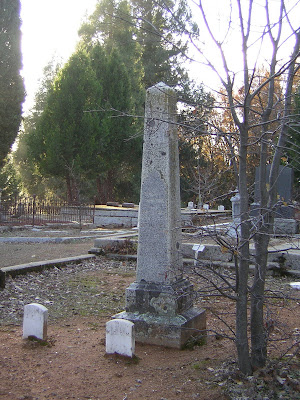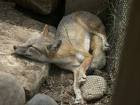I made another trip to the Sierra Foothills recently. This area is full of interesting cemeteries. Despite having been to Nevada City several times before, I had never been to Pine Grove Cemetery. It is truly lovely place.
Many of the symbols here are familiar. There are a lot of draped urns and interlocked hands.
A downward pointing hand represents the Hand of God. There was a time when you were not allowed to depict the image of God, so the hand was as close as the carver could get.
There are some new ones, as well. In this picture, you can see a tombstone topped with an open book. Closed books indicate a life ended, a story told. Open books are thought to represent the Bible.
I have come to the conclusion that the Sierra Foothills are a major hub for Freemasonry in California. They are all over the place. After saying in an earlier entry that I had never seen a Masonic keystone before, look what I found. Here's a whole flock of them in their own private enclosure, complete with Masonic pyramid.

A cross paired with a crown is also a Masonic symbol. When used in this manner, the crown stands for victory and the cross for Christianity. Its use on a tombtone means that the deceased was a member of the York Rite Masons, a branch of Masonry closely associated with the Knights Templar.
Another Templar symbol is the Maltese cross. This particular one has a Latin cross enclosed within it. The Latin cross is the most familiar symbol of Christianity.
The neatest symbol I saw in this cemetery is this one. I think it is meant to be the all-seeing eye, yet another Masonic symbol. If it looks familiar, check out the back of the $1 bill. When used with the three-link chain, however, it denotes the grave of a member of the Independent Order of Odd Fellows, known as the "poor man's Freemasonry". See what I mean? Everywhere.
One of the most striking features of this cemetery is the amazing ironwork that surrounds many of the plots.
The detail on this gate is incredible. Willow trees and lambs are worked into the design, indicating that these are the graves of children.
Many of the headstones are so old as to be illegible.
This was the oldest legible stone I could find. This grave marker is probably older, but I couldn't read it:
In this cemetery I found something I had never seen before: monuments that appeared to be made of metal, yet were very old. They held extraordinary detail.
After doing some research, I discovered these tombstone are made of cast zinc! The coating is zinc carbonate, which is highly rust-resistant. Apparently, these monuments were not popular, and the "white bronze" label was used to boost their appeal. The Western White Bronze Company of Des Moines closed its doors in 1908. For a fascinating and detailed analysis of these metal monuments, check out this web page.
This is the most unusual tombstone I have ever seen. I can only offer a theory as to its meaning. The diamond-shaped portion fits into the lower half using a V-shaped protrubance. If you bisect the diamond, you are left with two triangles. The bottom triangle is the ancient symbol of the sacred feminine, the Chalice. The upper triangle equates to the masculine symbol of the Blade. When the two symbols fit together, they indicate the marriage of male and female into a perfect partnership: two halves of the same whole. This is my personal theory, but if my interpretation is correct, this is the only tombstone I have ever come across with purely Pagan symbolism.
I could write about this cemetery forever. It is definitely one of the most fascinating and symbol-rich I have visited so far. I highly recommend it anyone who enjoys crawling through graveyards. Here are some last images of this extraordinary place.
Look! The grave of Sherlock Holmes? Probably not, but wouldn't be magical if it were true?














































